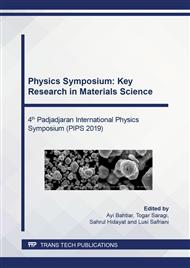p.28
p.34
p.42
p.53
p.59
p.64
p.69
p.75
p.83
Synthesis of Carboxymethyl Cellulose Form Banana Stems and its Characterization for Anode Binder of Li-Ion Battery
Abstract:
Banana (Musa acuminate) is one of the important fruit crop cultivated in Indonesia. Banana stems is waste biomass form banana farming which the amount is very abundant. Recently, the banana stems waste was used for animal feed, but the amount is small, mostly goes as waste. Banana stems have a high cellulose and hemicellulose content, more than 60%, which made it useful for row material of Carboxymethyl Cellulose (CMC). In this paper, we synthesized CMC from banana stems and apply it as binder in the electrodes of lithium ion battery. The steps of synthesizing CMC from banana stems started with the isolation of the cellulose, then followed by the processes of alkalization, carboxymethylation and finally the purification. FTIR spectrum shows the absorption bands at 3427 cm-1, 2928 cm-1, 1613 cm-1 and 1420 cm-1 which indicated the successfully of CMC synthesized. The presence of strong absorption bands at 1613 cm-1 and 1420 cm-1 are related to the stretching vibration of the carboxyl group (COO-) and (COO-Na). The peak absorption at around 2928 cm-1 is due to stretching vibration of all hydrocarbon constituent in CMC. While the broad absorption around 3427 cm-1 is due to the stretching vibration of the hydroxyl groups (-OH). The purity test of CMC mesh-100 is resulting the purity values of 99.84%. These results prove that CMS has actually been formed with high purity. In the application of CMC as anode binder, the best composition is 3 % CMC, where it gives the highest conductivity of 0.457 S/cm. Voltammogram cyclic measurement with a scan rate of 50 mV/s in the voltage range of -1.2 to 1.2 Volt gives the capacitance value of 18 mF.
Info:
Periodical:
Pages:
59-63
Citation:
Online since:
August 2020
Price:
Сopyright:
© 2020 Trans Tech Publications Ltd. All Rights Reserved
Share:
Citation:


